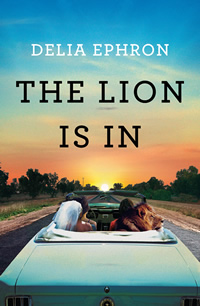Seeing the name Ephron attached to a book, movie, or theatrical production is a pretty safe bet that said entertainment product will bring the funny; after all, sisters Delia and Nora Ephron are two of the reigning American comedy writers, both independently and as a duo. Delia Ephron—she’s the one behind the screenplays for You’ve Got Mail and The Sisterhood of the Traveling Pants, among others, and is the author of several novels for adults and young readers—has a new book out this summer. The Lion Is In opens with a trio of women on the run—from their pasts, their partners, and their own bad habits.
Derailed by a car accident, Lana, Tracee, and Rita break into a ramshackle roadhouse called The Lion, right off the highway in North Carolina. (Tracee happens to be wearing a wedding dress, but Ephron doesn’t reveal the story behind that detail until well into the novel.) After crashing at the bar overnight, the ladies discover that they’re not alone: A real, live lion named Marcel is caged on premises—and somehow, while they’re asleep, Tracee’s veil ends up atop his head.
So begin the adventures of the three women, who join The Lion’s waitstaff while they wait for Lana’s Mustang to be repaired. Rita, the eldest of the three, is drawn to the caged lion and works to earn his trust. Before long, she and Marcel are causing quite a stir, giving a much-needed boost to The Lion’s patronage.
 The Lion Is In is an ideal porch or beach pick, a “read-in-one sitting, feel-good celebration of resiliency and hope,” as Booklist puts it. In advance of her appearance at the Nashville Film Festival, Ephron answered questions from Chapter 16 via email.
The Lion Is In is an ideal porch or beach pick, a “read-in-one sitting, feel-good celebration of resiliency and hope,” as Booklist puts it. In advance of her appearance at the Nashville Film Festival, Ephron answered questions from Chapter 16 via email.
Chapter 16: I’ve read that The Lion Is In came to you as a dream, in astonishing detail, right down to the characters’ names and ages, the setting, and of course the caged lion. Do your dreams often provide inspiration? And what did you eat the night you dreamed The Lion Is In?!
Ephron: A dream as an inspiration for a novel or movie? It has never happened to me before. It wasn’t what I ate—I was anxious about something (not being namejacked, that was another time) —and I thought that this anxious situation wasn’t going to resolve for weeks, so what do I do? And that night I had the dream. And I knew it was my next book. I started writing the next morning, about three women on the run and a lion that changes their lives. I lived inside that story every day—it was a total comfort to me, long after the anxious thing was over. It was like giving myself a gift.
The confusing and astonishing part was that many things I had [already] written I actually found when I visited North Carolina after I wrote the second draft. I had never been to North Carolina before, so how did I know what was there?
Chapter 16: Your range as a storyteller is enormous: you’re a novelist, a screenplay writer, a playwright. You’ve acknowledged that The Lion Is In is very cinematic, but you’ve also said that you couldn’t imagine it as anything but a novel. How do you know, or decide, what form a story idea should take?
Ephron: When I woke up from the dream I wasn’t absolutely sure whether it was a novel or a screenplay. But the story is immensely personal. It contains all the major themes of my life, and I knew the story was a piece of my heart. Movies are collaborations—and the writer is the least valuable piece of the puzzle. A screenwriter can be fired. A movie is often an attempt to please other people. And they often don’t get made. And rarely do screenplays have the depth that a novel has. So I wanted to write The Lion Is In first as a novel, my way. Then later maybe as a movie. It would be a terrific movie, I think. We’ll see.
 But usually things/stories tell you exactly what they are. Love Loss and What I Wore, for instance: When Nora and I read the book by Ilene Beckerman, it was clear to both of us that it was a theater piece. There was no driving single story line, which a movie has to have, and I believe a novel should too. It was going to be women telling stories about their lives and their clothes. A theater piece.
But usually things/stories tell you exactly what they are. Love Loss and What I Wore, for instance: When Nora and I read the book by Ilene Beckerman, it was clear to both of us that it was a theater piece. There was no driving single story line, which a movie has to have, and I believe a novel should too. It was going to be women telling stories about their lives and their clothes. A theater piece.
Chapter 16: The protagonists in this book are two twenty-something women and a fifty-something woman. Why don’t we see this mix of ages in novels and movies about women more often?
Ephron: I have so many friends of different ages. Also I am so buoyed in life by sisterhood—of my three sisters and my close friends. Part of what saves Lana, Tracee, and Rita’s life is their sisterhood, and part of it is Marcel the lion. Marcel is a force.
Chapter 16: Have you seen things change significantly in the years you’ve been in the business of writing funny stories for and about women?
Ephron: Yes: there are more and more women comedians. Tons of funny women. And that is completely fantastic.
Chapter 16: What’s your best advice for writers who aspire to write smart, fresh romantic comedy?
Ephron: My main advice for a writer is to write from your heart. Never look out there to see what’s popular and try to imitate.
Chapter 16: I especially loved your recent piece in The New York Times about being name-jacked online because I’ve suffered the same thing. As annoying as that experience was, you found the comedy, or at least absurdity, in it. Do you typically see the potential for humor in places where most people might not find it? Like the annual gyno visit or a trip to the DMV?
Ephron: I hope you got your name back. Yes, everything is potentially funny. The luck of being a writer.
Delia Ephron will appear at the Regal Green Hills Cinemas on April 24 at 5:30 p.m. as part of the Nashville Film Festival. Click here for ticket information.
Tagged: Fiction





